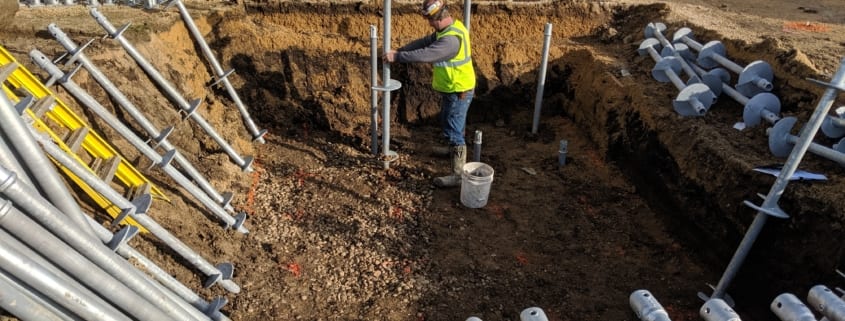
The Cross Lock allows for instant alignment, all torque is held in our patented coupling which ensures there is no hole deformation, this will save you time and money. You will not spend extra time, or need extra help threading a bolt through deformed holes.
Round shaft helicals are used in compression applications, they allow for a superior lateral stability, which is reducing twisting and deflection, and it will have a greater load capacity. Square shaft helicals are used for tension applications, they have a greater yield, superior tensile strength, as well as a higher torque capacity.
Most likely if you are looking into helicals they work for your application. Applications range from repair of home foundations, to using them to pin down circus tents, and everything in between. The main thing is to determine if the application will use round shaft, square shaft, have plans, and ensure you know about the soil you will be installing in.
PierTech offers a variety of patented products that will save lots of time and money on labor, make installation easier, and the products cannot be found anywhere else in the industry. Helical piers are superior to many other methods like, push piers, hand-dug concrete piers, and more. These other products are very time consuming, often messy, and very labor intensive. The products requiring concrete must have time to cure and be installed in ideal weather conditions. Helical piers can be installed in all weather conditions, are cost-effective, can be installed in limited access situations, and are virtually vibration free.
Helical piles are at times galvanized to prevent rusting, and dependent on soil type, and application. In general with normal soil conditions helicals will last around 150 years.
There are many popular applications, most popular being residential and commercial uses for helicals which includes using them under most structures for new construction and repair. They can be used in 80-90% of soil conditions that you may come across.
Helical piles are often used to put under homes or other foundations that are sinking, this will save the home, building, or other structure from receiving additional structural damage. When the helical is used with the Tru-Lift system, the structure can be secured, and this will prevent further settling, or it will bring the foundation back to the original height.
Many helicals are often installed 10-25 feet below the soil. Within plans for the project there will be a specified, or even recommended depth to ensure you achieve the torque requirements. Some helicals can go as deep as 100 feet.
When working with helicals a rule that should always be followed is spacing 3-4 diameters on center. Standard projects for helicals the spacing is between 5-10 feet apart. This will vary from project to project depending on the application.
When installing helical piles you can use a skid steer, mini excavator, full-size excavator, or backhoe. You will also need the equipment and accessories for install, PierTech offers a full line of equipment that includes attachments, and custom attachments to ensure it will work with your machine. PierTech even offers handheld equipment for installation in limited access areas.